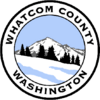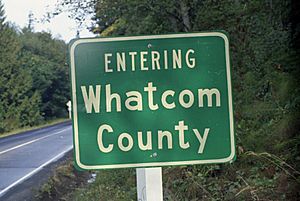Whatcom County, Washington facts for kids
Quick facts for kids
Whatcom County
|
||
|---|---|---|
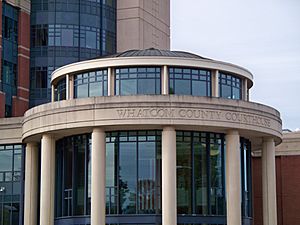
Whatcom County Courthouse in Bellingham
|
||
|
||
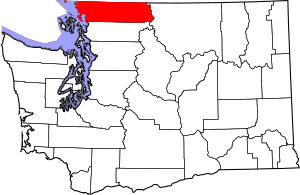
Location within the U.S. state of Washington
|
||
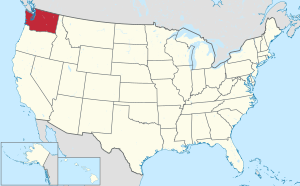 Washington's location within the U.S. |
||
| Country | ||
| State | ||
| Founded | March 9, 1854 | |
| Named for | Chief Whatcom | |
| Seat | Bellingham | |
| Largest city | Bellingham | |
| Area | ||
| • Total | 2,503 sq mi (6,480 km2) | |
| • Land | 2,107 sq mi (5,460 km2) | |
| • Water | 397 sq mi (1,030 km2) 16%% | |
| Population
(2020)
|
||
| • Total | 226,847 | |
| • Estimate
(2022)
|
230,677 |
|
| • Density | 103/sq mi (40/km2) | |
| Time zone | UTC−8 (Pacific) | |
| • Summer (DST) | UTC−7 (PDT) | |
| Congressional district | 2nd | |
| Website | https://www.whatcomcounty.us/ | |
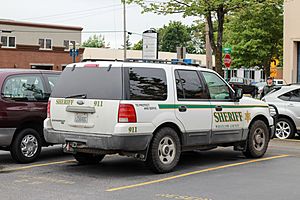
Whatcom County is a county in the northwestern part of Washington state. It shares a border with British Columbia, Canada, to the north. To its east is Okanogan County, and to the south is Skagit County.
The county's main city and government center is Bellingham. In 2020, about 226,847 people lived here.
Whatcom County was created in March 1854. Its name comes from the Lummi word Xwotʼqom. This word might mean "noisy" or "noisy water," possibly referring to a waterfall. The county has a varied economy. It is especially known for growing raspberries. About 60% of all raspberries grown in the United States come from Whatcom County.
Contents
History of Whatcom County
People have lived in the Whatcom County area for at least 12,000 years. Three main Native American tribes lived here: the Lummi, Nooksack, and Semiahmoo peoples.
In the early 1800s, this area was part of the Oregon Country. Both Canadian fur traders and American settlers were interested in the land. Since both countries claimed the area, they agreed to share control in 1818. The Hudson's Bay Company even set up a trading post called Fort Langley in 1827.
The Washington Territory was formed in 1853. In 1854, Whatcom County was officially created from parts of Island County. Over time, parts of Whatcom County were used to form other counties, like San Juan County in 1873 and Skagit County in 1883.
In 1855, settlers built a blockhouse (a small fort) to protect themselves. That same year, the Treaty of Point Elliott was signed. This treaty set aside smaller areas of land for the Lummi and Semiahmoo peoples.
A gold rush in the Fraser Canyon (1857–1858) brought many people to the county for a short time. The population grew to over 10,000, but then it quickly went back down. In 1857, the US government began marking the border with Canada. This border, the 49th parallel, also became the northern line of Whatcom County.
Border Crossings
Whatcom County shares its northern border with British Columbia, Canada. Many people cross this border for travel and shopping.
Here are the main border crossing points, from west to east:
- The Point Roberts–Boundary Bay Border Crossing connects Point Roberts to Tsawwassen, British Columbia.
- The Peace Arch Border Crossing is where Interstate 5 meets British Columbia Highway 99.
- The Pacific Highway Border Crossing connects Washington State Route 543 with British Columbia Highway 15.
- The Lynden–Aldergrove Border Crossing connects SR 539 to British Columbia Highway 13.
- The Sumas–Huntingdon Border Crossing is at Sumas, connecting SR 9 to Abbotsford, British Columbia.
- There is also an unmanned crossing between British Columbia's Skagit Valley Provincial Park and North Cascades National Park.
Many stores and services in Bellingham are popular with people who cross the border from Canada.
Geography of Whatcom County
Whatcom County covers about 2,503 square miles. About 2,107 square miles are land, and 397 square miles (16%) are covered by water.
The western part of Whatcom County is a flat area called the Fraser Lowland. This plain is mostly in British Columbia. The rest of Whatcom County is in the Cascade Range, which includes Mount Baker.
Mount Baker is an active volcano and the highest point in the county. It stands at 10,778 feet above sea level. The lowest points are at sea level along the Salish Sea, which is part of the Pacific Ocean.
Geographic Features
- Bellingham Bay
- Birch Bay
- Cascade Mountains
- Chuckanut Mountains
- Mount Baker, highest point in Whatcom County
- American Border Peak
- Sumas Mountain
- Mount Shuksan
- Chilliwack River/Chilliwack Lake
- Eliza Island
- Lake Whatcom
- Lummi Island
- Lummi Bay
- Nooksack River
- North Lookout Mountain, also known as Galbraith Mountain
- Portage Island
- Semiahmoo Bay
- Skagit River/Ross Lake
- Sumas River
National Protected Areas
- Mount Baker National Recreation Area
- Mount Baker–Snoqualmie National Forest (part)
- North Cascades National Park (part)
- Ross Lake National Recreation Area (part)
- Pacific Northwest National Scenic Trail (part)
State Protected Areas
- Birch Bay State Park
- Lake Terrell Wildlife Refuge
- Larrabee State Park
- Lookout Mountain (DNR)
- Lummi Island (part) (DNR)
- Stewart Mountain (DNR)
- Lake Whatcom Watershed
Major Highways
- Interstate 5 connects to cities like Seattle, Portland, and Los Angeles.
- SR 20 connects to U.S. Route 101 and goes through the North Cascades Highway. This is the farthest north highway through the Cascade Mountains in the USA.
- Alaska Marine Highway connects Alaska highways to the Interstate Highway System.
Adjacent Counties
- Metro Vancouver Regional District, British Columbia – north
- Fraser Valley Regional District, British Columbia – northeast
- Cowichan Valley Regional District, British Columbia – west
- Capital Regional District, British Columbia – west
- Okanogan County – east
- San Juan County – southwest
- Skagit County – south
Population of Whatcom County
| Historical population | |||
|---|---|---|---|
| Census | Pop. | %± | |
| 1860 | 352 | — | |
| 1870 | 534 | 51.7% | |
| 1880 | 3,137 | 487.5% | |
| 1890 | 18,591 | 492.6% | |
| 1900 | 24,116 | 29.7% | |
| 1910 | 49,511 | 105.3% | |
| 1920 | 50,600 | 2.2% | |
| 1930 | 59,128 | 16.9% | |
| 1940 | 60,355 | 2.1% | |
| 1950 | 66,733 | 10.6% | |
| 1960 | 70,317 | 5.4% | |
| 1970 | 81,950 | 16.5% | |
| 1980 | 106,701 | 30.2% | |
| 1990 | 127,780 | 19.8% | |
| 2000 | 166,814 | 30.5% | |
| 2010 | 201,140 | 20.6% | |
| 2020 | 226,847 | 12.8% | |
| 2022 (est.) | 230,677 | 14.7% | |
| U.S. Decennial Census 1790–1960 1900–1990 1990–2000 2010–2020 |
|||
In 2010, Whatcom County had 201,140 people living there. The population density was about 95.5 people per square mile. Most people (85.4%) were White. About 3.5% were Asian, and 2.8% were American Indian. People of Hispanic or Latino origin made up 7.8% of the population.
The average age of people in the county was 36.6 years old.
Economy of Whatcom County
In the 1850s, coal mines, sawmills, and a military fort were built in Whatcom County. At first, logging was the main business. As land was cleared, farming also grew. Canneries, which packaged fish and crops, sent the county's products to many places.
Pacific American Fisheries became the world's largest canning company in 1899. It employed thousands of people. Smaller canneries also produced a lot of canned salmon. The Fairhaven Shipyard built many fishing ships and even freighters during World War I.
Today, Whatcom County is famous for its raspberries. It produces 60–80 million pounds of raspberries each year. This is about 99% of Washington's raspberry crop and around 85% of the entire United States' harvest.
Activity across the Canadian border also plays a big part in the county's economy.
Education in Whatcom County
Whatcom County has many public and private schools for students from preschool to high school. Public schools are run by eight different school districts. Each district has its own elected school board.
Here are some of the school districts:
- Bellingham School District serves Bellingham and nearby areas.
- Blaine School District serves Blaine, Birch Bay, and Point Roberts.
- Ferndale School District serves Ferndale, Custer, Lummi Island, and the Lummi Nation.
- Lynden School District serves Lynden and its surrounding areas.
- Mount Baker School District serves communities along the Mount Baker Highway.
- Nooksack Valley School District serves Everson, Nooksack, and Sumas.
There are also many private schools, such as Assumption Catholic School and Lynden Christian Schools.
Higher Education
Whatcom County is home to several colleges and universities:
- Western Washington University (Western) is a large public university. It offers many bachelor's and master's degrees.
- Whatcom Community College is a public college that offers certificate programs and associate degrees.
- Bellingham Technical College is a public college focused on technical and vocational training.
- Trinity Western University (TWU) has a branch campus in Bellingham. It offers undergraduate courses.
- Northwest Indian College is a college supported by the Lummi Nation. It serves the Native American community.
Communities in Whatcom County
Cities
Census-designated places
- Acme
- Birch Bay
- Custer
- Deming
- Geneva
- Glacier
- Kendall
- Maple Falls
- Marietta-Alderwood
- Peaceful Valley
- Point Roberts
- Sudden Valley
Unincorporated communities
- Blue Canyon
- Chuckanut
- Clearbrook
- Clipper
- Dewey
- Diablo
- Laurel
- Lummi Island
- Newhalem
- Saxon
- Semiahmoo
- Van Buren
- Wahl
- Welcome
- Wickersham
Ghost Towns
Notable People
- Steve Alvord, a football player in the NFL
- Tim Soares, a basketball player
- Ryan Stiles, an actor and comedian
- Hilary Swank, an award-winning movie actress
See also
 In Spanish: Condado de Whatcom para niños
In Spanish: Condado de Whatcom para niños


